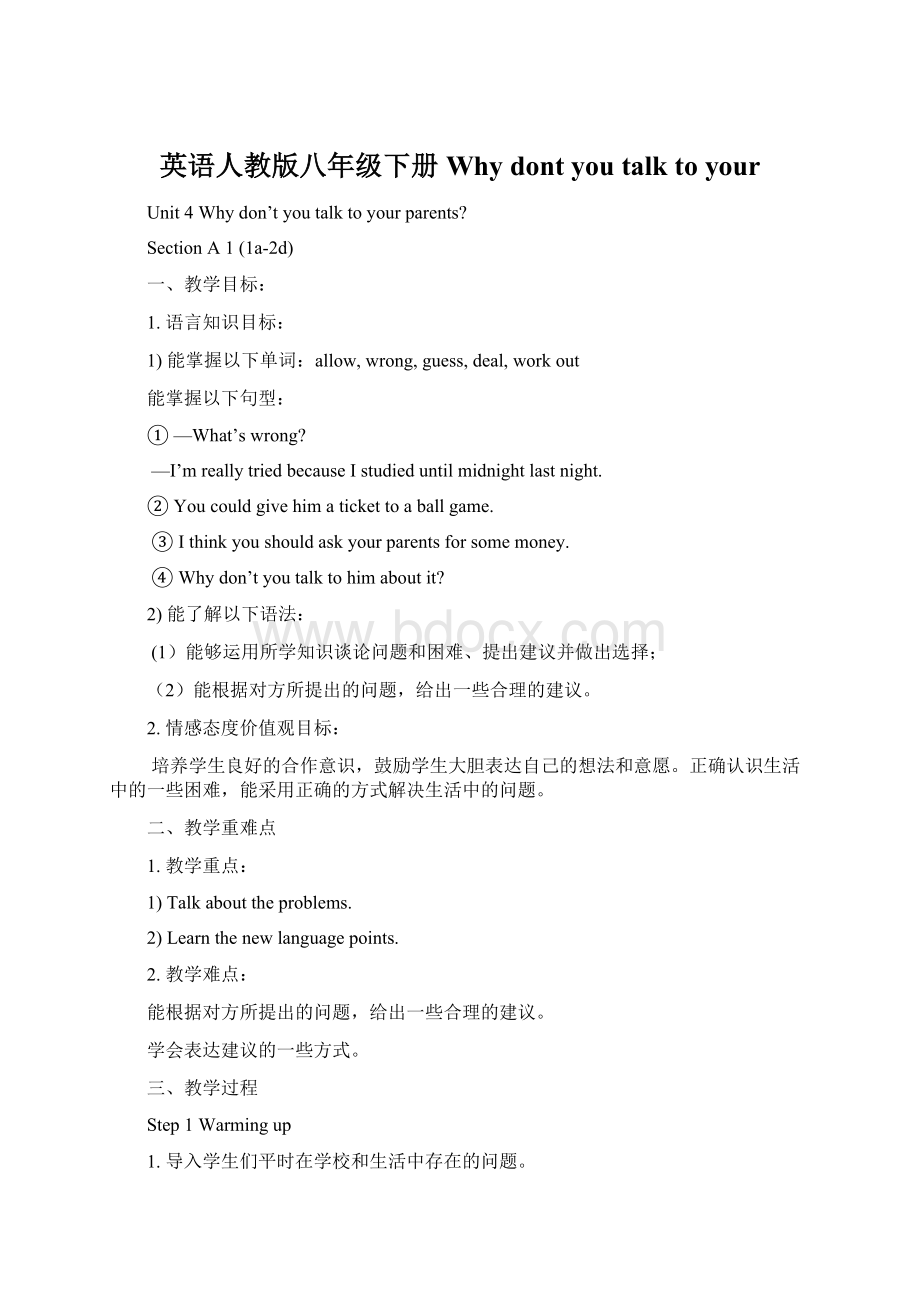英语人教版八年级下册Why dont you talk to your.docx
《英语人教版八年级下册Why dont you talk to your.docx》由会员分享,可在线阅读,更多相关《英语人教版八年级下册Why dont you talk to your.docx(35页珍藏版)》请在冰豆网上搜索。

英语人教版八年级下册Whydontyoutalktoyour
Unit4Whydon’tyoutalktoyourparents?
SectionA1(1a-2d)
一、教学目标:
1.语言知识目标:
1)能掌握以下单词:
allow,wrong,guess,deal,workout
能掌握以下句型:
①—What’swrong?
—I’mreallytriedbecauseIstudieduntilmidnightlastnight.
②Youcouldgivehimatickettoaballgame.
③Ithinkyoushouldaskyourparentsforsomemoney.
④Whydon’tyoutalktohimaboutit?
2)能了解以下语法:
(1)能够运用所学知识谈论问题和困难、提出建议并做出选择;
(2)能根据对方所提出的问题,给出一些合理的建议。
2.情感态度价值观目标:
培养学生良好的合作意识,鼓励学生大胆表达自己的想法和意愿。
正确认识生活中的一些困难,能采用正确的方式解决生活中的问题。
二、教学重难点
1.教学重点:
1)Talkabouttheproblems.
2)Learnthenewlanguagepoints.
2.教学难点:
能根据对方所提出的问题,给出一些合理的建议。
学会表达建议的一些方式。
三、教学过程
Step1Warmingup
1.导入学生们平时在学校和生活中存在的问题。
T:
What’sthematter/What’swrong?
S:
Hehastoomuchhomeworktodo.
T:
Doheliketodoit?
S1:
No,hedoesn’t.Becausehedoesn’thaveanyfreetimetodothingshelikes.
…
Step2Talking
1.Lookattheseproblems.Doyouthinktheyareseriousornot?
Ssdiscusswiththeirpartnersandgivesomeadvice.
①IhavetostudytoomuchsoIdon’tgetenoughsleep.
②IhavetoomuchhomeworksoIdon’thaveanyfreetimetodothingsIlike.
③Myparentsdon’tallowmetohangoutwithmyfriends.
④Ihavetoomanyafter-schoolclasses.
⑤Igotintoafightwithmybestfriend.
Step3Listening
1.T:
TellSstoreadthesentencesin1aagain.Makesuretheyknowthemeaningofthesentences.Whatproblemsaretheytalkingabout?
2.PlaytherecordingfortheSstolistenandcircletheproblemsyouhearin1a.
3.Playtherecordingagain.ChecktheanswerswiththeSs.
Step4Pairwork
1.LetSsreadtheconversationinthebox.
2.Usetheinformationin1atomakeotherconversations.
3.Letsomepairsactouttheirconversations.
e.g.A:
What’swrong?
B:
I’mreallytiedbecauseIstudieduntilmidnightlastnight.
A:
Whydon’tyougotosleepearlierthisevening?
Step5Listening
Workon2a:
T:
Peterhassomeproblems.Whatadvicedoeshisfriendgivehim?
Fillintheblankswithcouldorshould.
1.LetSsreadthesentencesin2a.
2.PlaytherecordingfortheSstolistenandwritethewordsintheblank.
3.Playtherecordingagaintochecktheanswers.
Workon2b:
1.LetSsreadthesentencesbelow.ExplainsomemainsentencesfortheSs.Makesuretheyknowthemeaningofeachsentence.
2.PlaytherecordingfortheSstowritetheletters(a-e)nexttotheadvicein2a.
3.Playtherecordingagaintochecktheanswers.
Step6Pairwork
1.TellSstomakeaconversationusingtheinformationin2aand2b.
2.Letonepairtoreadouttheirconversationfirst.
3.e.g.A:
What’sthematter,Peter?
B:
Ihadafightwithmybestfriend.WhatshouldIdo?
A:
Well,youshouldcallhimsothatyoucansayyou’resorry.
B:
ButIdon’twanttotalkaboutitonthephone.
4.Ssacttheconversationinpairs.Asksomepairstoactouttheirconversations.
Step7Role-play
1.Ssreadtheconversationsandtrytounderstandthemeaning.
2.Readtheconversationaftertheteacher.
3.Answerthequestions.
1)HowdoesKimfeelabouthersisterafterhersistergavebackthethings?
2)DoesDavethinkitisallrightforKim’ssistertotakeawayKim’sthings?
Howdoyouknow?
3)DoesDavethinkthetwosistershaveaseriousproblem?
Howdoyouknow?
4)WhatdoesDavemeanbysaying“Hopethingsworkout”?
4.Practicetheconversationwiththeirpartner.Thenletsomepairstoactouttheconversation.
5.Explainsomenewwordsandmainpointsintheconversation.
Homework:
Writethreeconversationsaboutyourproblemsandyourfriends’suggestions.
A:
Ihavetoomanyafter-schoolclasses.
WhatcouldIdo?
B:
Youcould…
SectionA2(3a-3c)
一、教学目标:
1.语言知识目标:
1)学习掌握下列词汇:
getonwith;relation,communication,argue,cloud,elder,instead,whatever,nervous,offer,proper,secondly,communication,explain,clear
2)阅读短文,能按要求找到相应的信息。
3)通过阅读提高学生们的阅读能力。
4)了解在如果生活中发生了一些不尽如人意的问题,应当如何面对理性地去解决。
2.情感态度价值观目标:
人的一生并不都是一帆风顺的,难免有一些挫折的困难,如果生活中发生了一些不尽如人意的问题,我们学会冷静对待,学会合理的办法去理性地去解决。
二、教学重难点
1.教学重点:
1)掌握本部分出现的生词和词组,达到熟练运用的目标。
2)阅读短文,获得相关的信息。
通过阅读练习,来提高阅读能力。
2.教学难点:
1)阅读短文,获得相关的信息的能力。
2)理解并运用所学的词汇及表达方式。
三、教学过程
Step1Revision
SomeSsgivesomeproblems.OtherSsgiveadvice.
Problemsandadvice:
Step2Presentationthenewwords
Step3Lead-in
一、通过问答一些有关家庭生活的问题来导入正题:
1.Canyougetonwellwithyourfamily?
2.Aretherelationsbetweenyourparentsgood?
3.Doyouhaveanybrothersorsisters?
Canyougetonwellwithhim/her?
4.Whodoyouaskforhelpwhenyouhaveproblems?
…
Step4Reading
Workon3a:
1.TellSstoreadthearticlein3aquicklyandtrytofindtheanswerstothesequestions:
What’sSadandThirteen’sproblem?
Howdoeshefeelathome?
方法指导:
带着问题,然后快速阅读短文,争取在较短的时间内,找到答案。
学生们,按老师指导的方法进行阅读,并快速回答这两个问题。
最后,教师让部分学生回答答案,并校对答案。
2.Ssreadthearticleagainandfillinthechart.
学生们认真阅读短文,并在表格中填出男孩SadandThirteen面临的问题,并填写出罗波特先生所给出的建议。
和同学们一起校对答案。
3.Ssreadthearticleagainandfillintheblanks.
Workon3b:
1.让学生们讨论罗波特先生对问题的建议,并发表自己的看法。
2.学生们分小组讨论,发表自己的意见,由小组长汇总。
3.让小组长并汇总的意见和其他同学汇报。
Workon3c
1.告诉学生们本学习活动的要求:
找出短文与下列词汇意思相同的句子。
2.让学生们先读3c中的词汇,理解其意思,然后再在短文找出与其意思相同的词汇或词组。
3.方法指导:
根据上下文的意思,来确定词汇或词组的意思。
4.Checktheanswers。
5.让学生们用这些词汇或词组造句子。
Step5Languagepoints
Step7Homework
1.Readthearticleseveraltimesafterschool.
2.Makesentenceswiththesewords:
argue;whatever;instead;nervous;explain;offertodosth.;communicatewith…
SectionA3(Grammarfocus-4c)
一、教学目标:
1.语言知识目标:
1)学习掌握下列词汇:
copy,return
2)进行一步复习巩固学习SectionA部分所学的生词和词组。
3)对询问困难及提出的建议的句型,掌握其规则。
4)通过不同方式的练习,来熟练运用询问及提建议的表达方式。
2.情感态度价值观目标:
让学生了解每个人在生活中都有可能遇到一些挫折和不幸,我们多去向那些不幸和困难的人们多表示自己的爱心,多去理解和帮助他们,多向他们提出解决问题的建议而不是去嘲笑他们。
二、教学重难点言
1.教学重点:
1)复习巩固SectionA部分所学的生词和词组,达到熟练运用的目标。
2)熟练掌握和运用询问困难和提建议的表达方式。
2.教学难点:
1)总结询问问题和提出建议的句型,掌握规则。
2)练习运用所学的句型。
三、教学过程
Step1Warming-upandrevision
1.Haveadictationofthenewwordslearnedinthelastclass.
1.makesth.clear(同义词)___________
2.talk(同义词)_______________
3.notallow(同义词)______________
4.worried(同义词)______________
5.getalongwith(同义词)____________
6.communicate(名词)_____________
7.old(比较级)_______________
2.Checkthehomework.
3.LetsomeSsreadthearticlein3a.ThenfinishtheshortpassageaboutSadandThirteen.(见课件)
Step2Grammarfocus.
Step3TrytoFind
一、提出建议
1.掌握提出问题的方法,
What’swrong?
What’sthematter?
withsb.
What’stheproblem/thetrouble?
并能讨论所给出的建议。
情态动词should,should等
should,shouldn’t“(不)应该”,常用来提出请求和建议
could“可以”可也用来给出建议。
表建议的句型:
ØYoushould/could+v.
ØWhydon’tyou+v.?
ØWhynot+v.?
ØCouldyouplease+v.?
ØYou’dbetter(not)+v..
ØWouldyouminddoing……?
ØWhatabout/Howabout+n./doing……?
Exercise:
一、用所给单词的适当形式填空
1.Weshouldn’t_______(argue)withourparents.
2.Youshouldn’t____(use)thephoneintheclassroom.
3.—CouldIuseyourdictionary?
—Well,you___.
A.canB.couldC.shouldD.might
4.You’dbetter_____(go)toschoolbybike.
5.Howabout________(go)hikingthisafternoon?
Step5Practice
Workon4a:
1.Fillintheblankswithalthough,sothatoruntil.
2.方法指导:
1)点拨:
sothat意为“因此”,引导目的状语从句,表示前一句所表述的动作的目的。
在从句中常使用can/could/will/may/should等词。
拓展:
so…that…意为“如此……以至于”,常用于结果状语从句,表示上文动作所产生结果。
2)点拨:
句意“尽管你现在没有朋友,但不久你就会有朋友的。
”although是连词,意为“尽管……但是”,同though一样引导让步状语从句。
它们引导的让步状语从句既可放在主句之前,也可放在主句之后。
另外,在英语中although或though不能和but同时出现在一个句子中,但它们之间可进行句型转换。
如:
Although/Thoughtheweatherissunny,Ifeelcold.
Ifeelcoldalthough/thoughtheweatherissunny.
Although/Thoughitisraining,buttheyarestillplayingoutside.(×)
→Although/Thoughitisraining,theyarestillplayingoutside.=Itisraining,buttheyarestillplayingoutside.(√)
3)点拨:
until用于否定句中,表示句子的动作直到until短语所表示的时间才开始发生,即表示动作的起点。
一般译为“直到……才”。
拓展:
until用在肯定句中,表示句子的动作一直持续到until短语所表示的时间为止,即表示动作的终点。
一般可译为“直到……时(为止)”或“在……以前”。
在这种用法中,句子的谓语动词必须是持续动词(非瞬间动词),
e.g.Shewasabankclerkuntilthewar,whenshetrainedasanurse.她战前是个银行职员,战时受训当了护士。
4)点拨:
句意“尽管他是你的最好的朋友,但你还是应当告诉他,抄袭别人的作业是不对的。
”,可知空格处应用though。
Step6Givingadvice.
Step7Homework
用下列词组造句
putup,handout,callup,cheerup,comeupwith,giveout,putoff
SectionB1(1a-2e)
一、教学目标:
1.语言知识目标:
1)能掌握以下单词:
member,pressure,compete,opinion,skill,typical,football,cutout,continue,compare,compare…with,crazy,push,development,cause,usual
2)能掌握以下句型:
①IthinkWeiMingshould…
②Althoughyoumaybe…,youshouldtalktothem.
③Lifeshouldn’tjustbeabout…
④Whydon’ttheyjustlettheirkidsbekids?
⑤Althoughit’snormaltowantsuccessfulchildren,it’sevenmoreimportanttohavehappychildren.
2.情感态度价值观目标:
了解中国及一些其他国家中学生们普通存在的生活及学习上问题,了解别人的生活现状及他们苦恼,知道学习知识是很重要的事情,但它并不是生活的全部。
二、教学重难点
1.教学重点:
1)掌握本课时出现的生词及用法。
2)进行听力训练,提高综合听说能力。
3)阅读短文,获得相关信息,提高学生们的综合阅读能力。
2.教学难点
1.听力训练
2.阅读2b部分的短文并完成相关要求。
三、教学过程
Step1Revision
1.Dailygreeting.
2.复习提建议的表达方式,并完成相关任务。
3.Checkthehomework.LetsomeSsgiveadvice.
Step2Warmingup
1.T:
Showapictureofstudent.
—What’swrongwiththegirl?
—She’stoostressedout.
—Whatshouldshedo?
Canyougivehersomeadvice?
2.Ssdiscusstheproblemandgivesomeadvices:
e.g.
S1:
Whynothangoutwithherfriends.
S2:
Shecouldplaysports.
S3:
Shecouldplaycomputergames.
S4:
Sheshouldlistentomusicandreadsomebooks.
Step3Writing
Workon1b
1.Askonestudentreadthesentencesin1a.Explainsomemainsentences.
2.Whatactivitiesdoyouliketohelploweryourstress?
Orderthemfrom1-8withbeingthemostfavoritethingyoudotolowerstress.
3.Ssdiscusswiththeirdeskmatesthenorderthem.
4.LetsomeSssaytheiranswers
Ste